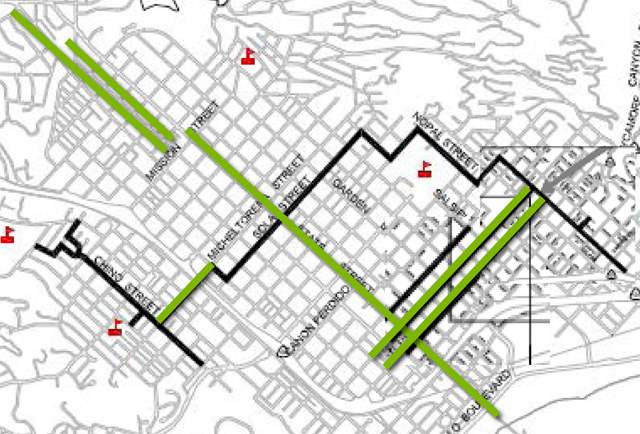New Bike Lanes Snag $7.2 Million in Critical State Funding
Routes Will Create a Path from the Westside to the Lower Eastside

The California Transportation Commission voted unanimously last week to fund two new bikeways proposed as part of the City of Santa Barbara’s recently approved Bicycle Master Plan to the tune of $7.173 million. The two new bikeways, when combined, will create a continuous route from the city’s Westside on Chino Street to the lower Eastside on Nopal.
Changes made to the proposed bike lane in response to Micheltorena Street neighborhood concerns and the threat of a lawsuit ultimately helped persuade the commissioners to fund the project. That’s because partisans on both sides of the debate — Santa Barbara Bicycle Coalition, Micheltorena Neighborhood Association, and City of Santa Barbara — showed up in significant numbers at last week’s commission meeting, held in Riverside, to voice their support. Initial plans called for the creation of a green-striped bike lane along Micheltorena Street from Castillo to State streets, but this entailed the removal of as many as 80 on-street parking spaces. When affected businesses and residents objected, city traffic planners went back to the drawing board and proposed a bicycle boulevard on Sola Street instead.
Transportation Commission staff were impressed the Sola Street alternative connected a bigger gap in the city’s bikeway network. They were also impressed by the extensive changes made to the plan in response to community concerns. That entered into deliberations because a small group of vocal and energetic opponents objected to the creation of a bicycle boulevard on Chino Street. Opponents argued the bike lane should be located on Gillespie instead, and they flooded the California Transportation Commission with “a cyber flurry” of emails in opposition. In fact, 115 pages of the commission’s 700-page staff report for last week’s meeting came from these opponents.
Although funding was approved for the new bikeways, actual disbursement won’t take place for five years because state gas-tax revenues have dipped to historic lows due to increased fuel efficiencies and lower gas prices.



